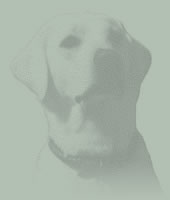 |
Sign Up For Our Newsletter!
 |
||
Veterinary Topics: Neonatal CareSee Also: Feeding
the Adult Labrador | Reproduction | Preventative
Medicine In the coming weeks we will be adding various topics dealing with Neonatal Care, as we follow from the whelping process, up to the time of weaning. If at any time you would like some additional information on these subjects you can email me at: whitelabs@bainbridgelabs.com PART I: UMBILICAL CARE
Once the cord has been properly separated, there still may be instances where bleeding persists a bit longer than you would prefer. This should be easily managed with firm pressure applied by your thumb and forefinger at the end of the umbilical stump. Usually a couple of minutes will do the job, but in the odd case where oozing persists and you would like to put it to rest, the use of a small hemostat will solve the problem. If you do not have one, simply tying a ligature around the far end of the stump with some sewing thread will get the job done. You can then remove the thread in several hours after the bleeding has stopped. I would not recommend leaving the ligature in place for any more time than is neccesary. Simply cut it loose and discard it. |
||
The Story of Bainbridge | About Us | What Others Are Saying | Memorials | The Home Team | Photography | Your New Puppy | Veterinary Topics | Dr.'s Newsletter | Contact Us | Online Store | Links | Home Page
White Labs by Dr. Joseph Demichael, DVM - The
Labradors of Bainbridge
Ph: (859) 299-6200 | Email: whitelabs@bainbridgelabs.com | Site
Map
© Dr. D’s for Dogs (USA) 2010, Lexington, Kentucky
All worldwide rights reserved. Dr. D’s for Dogs is a trademark
of Dr. J. Demichael, DVM


 As
the newborn begins to dry off and make his way towards that
first meal on "dry land", it is not too uncommon to find
a trail of blood under his abdomen caused by a leakage from
the recently severed umbilical vessels. Under most circumstances
these vessels rapidly contract in order to promote blood
clotting. But depending on the manner in which the blood
vessels are severed when the placenta is detatched, you might
see variable degrees of bleeding. There is much less chance
for blood loss when the vessels are cut in a crushing or
grinding manner (as the mother would do with her teeth),
as opposed to a sharp, clean cut as would come from using
a scalpel or scissors. So in those cases where the attendant
needs to help sever the cord, the use of a scissors, even
if available, is absolutely not indicated. Instead, consider
using your hands as follows: If you are right handed, grasp
the umbilical vessels an inch or two from the abdominal wall
using the thumb and forefingers of your left hand. While
the left hand keeps steady pressure on the cord so as not
to place undue stress on the abdominal wall during the process,
grasp the umbilicus again between your index finger and thumb,
this time of your right hand. (You should now have
the umbilicus in your left hand approximately 1-2 inches
from the abdominal wall and in your right hand 3-4 inches
from the wall). Firmly use your right thumb against the cord
in a scratching or scraping motion, back and forth, until
you separate the placenta from the newborn. Remember that
any pressure generated on the cord during this process should
be absorbed by the grasp of your left hand on the umbilicus.
It is imporant to prevent any undue pull on the navel area
as an inadvertent force could lead to an umbilical hernia.
Having personally used this process many, many times, I can
tell you that normal attention to this detail has never yet
resulted in a hernia.
As
the newborn begins to dry off and make his way towards that
first meal on "dry land", it is not too uncommon to find
a trail of blood under his abdomen caused by a leakage from
the recently severed umbilical vessels. Under most circumstances
these vessels rapidly contract in order to promote blood
clotting. But depending on the manner in which the blood
vessels are severed when the placenta is detatched, you might
see variable degrees of bleeding. There is much less chance
for blood loss when the vessels are cut in a crushing or
grinding manner (as the mother would do with her teeth),
as opposed to a sharp, clean cut as would come from using
a scalpel or scissors. So in those cases where the attendant
needs to help sever the cord, the use of a scissors, even
if available, is absolutely not indicated. Instead, consider
using your hands as follows: If you are right handed, grasp
the umbilical vessels an inch or two from the abdominal wall
using the thumb and forefingers of your left hand. While
the left hand keeps steady pressure on the cord so as not
to place undue stress on the abdominal wall during the process,
grasp the umbilicus again between your index finger and thumb,
this time of your right hand. (You should now have
the umbilicus in your left hand approximately 1-2 inches
from the abdominal wall and in your right hand 3-4 inches
from the wall). Firmly use your right thumb against the cord
in a scratching or scraping motion, back and forth, until
you separate the placenta from the newborn. Remember that
any pressure generated on the cord during this process should
be absorbed by the grasp of your left hand on the umbilicus.
It is imporant to prevent any undue pull on the navel area
as an inadvertent force could lead to an umbilical hernia.
Having personally used this process many, many times, I can
tell you that normal attention to this detail has never yet
resulted in a hernia.